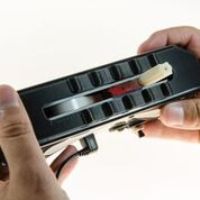Oct 14 2015
Demonstrating the life changing technologies being developed as a result of Governor Andrew Cuomo’s leadership in fostering public-private partnership opportunities, SUNY Polytechnic Institute’s Colleges of Nanoscale Science and Engineering (SUNY Poly CNSE) today announced a team of SUNY Poly CNSE researchers, including two graduate students, has developed a unique, optics-based tracking sensor for the “Jamboxx,” a harmonica-like device created by My Music Machines, Inc., based in Scotia, New York. The Jamboxx was originally designed for people with disabilities and enables individual creative expression by allowing users to control a number of music and art-based software programs with their breath.

“We are delighted to further Governor Andrew M. Cuomo’s vision for a vibrant high-tech sector in New York State as it strengthens local companies, such as the maker of the Jamboxx, by providing a valuable high-tech solution that will make the device more reliable for their customers,” said Dr. Alain Kaloyeros, President and CEO of SUNY Poly. “SUNY Poly CNSE is proud to play a role in the development of this sensor which will not only make the Jamboxx more resilient, but will also undoubtedly empower those with disabilities to move beyond current artistic limitations and take advantage of this unique technology which was created by New York State entrepreneurs My Music Machines, Inc. and enhanced by SUNY Poly CNSE researchers enabled by Governor Andrew Cuomo’s public-private model for innovative 21st Century growth.”
The Jamboxx’s original concept came about when David Whalen, a Scotia resident and quadriplegic, began to look for ways he could remain engaged with the world of music. Finding few legitimate options, he worked with friend Mike DiCesare to develop the Jamboxx, a USB-powered breath-controlled device that resembles a harmonica and comes with special software to allow musicians to play digital music or control a computer with varying levels of breath. The device consists of a tilt sensor for octave selection, a pressure sensor to produce sound, and a position sensor to track the movement of the mouthpiece.
As designed, the position slider had to make physical contact with a sensor, however, and over time the slider wore out and failed. After hearing about SUNY Poly CNSE Professor and Head of the Nanobioscience Constellation Dr. Jim Castracane’s research related to novel sensors, the Jamboxx creators connected with Dr. Castracane who found that a Self-Balancing Position Sensitive Detector (SBPSD) would make the Jamboxx more resistant to normal wear by avoiding a contact-method to track an input. The Silicon-based linear detector was fabricated in SUNY Poly cleanrooms and is designed to track an LED, which was added to the mouthpiece of the Jamboxx. After obtaining research grants from the New York State Trade Adjustment Assistance Center (NYSTAAC) and funds from My Music Machine, Inc. and support from SUNY Poly CNSE, the SBPSD was developed without the need for any external electronics. It is extremely low cost, and provides excellent time response.
“Having heard that SUNY Poly CNSE’s leading-edge researchers are deeply involved with photonics-based sensors, we were eager to see if they might be able to offer a solution that would make our unique musical device, the Jamboxx, able to withstand the amount of use it was seeing from our many inspired customers,”said My Music Machines, Inc. Co-Owner Mike DiCesare. “Partnering with SUNY Poly CNSE, we saw first-hand how it is an unmatched resource for businesses like ours, and with an improved product, we now look forward to branching out to share similar devices with music teachers and even children who can experience the joy of music and art through this unique approach to personal expression.”
“In concert with Governor Andrew Cuomo’s high-tech blueprint for New York State, our SUNY Poly CNSE research group is excited to work with My Music Machines, Inc. to provide them with an elegant cost-effective solution that will ensure their customers, many of whom have disabilities, are able to feel empowered and can enjoy countless hours creating music with their Jamboxx,” said Dr. Castracane. “This was not only a rewarding challenge for me, but a powerful learning opportunity for two SUNY Poly CNSE graduate students who were able to put their skills to the test while giving back to those who may have physical disabilities, but with the right tools, are just as capable as anyone in showcasing their artistic vision.”
Dr. Castracane’s research group is currently in the process of applying for a provisional patent for the SBPSD, a key component in the Jamboxx. Additionally, discussions are underway to manufacture the sensors at a high-volume fabrication facility such as CNSE’s Smart System Technology & Commercialization Center (CNSE’s STC), located in Canandaigua, New York, and utilizing packaging companies in the region such as Hudson Valley Technology Development Center.
Photos for publication are available by clicking here. https://www.dropbox.com/sh/0qq4l3rdtdmvpko/AABUC64fCrHaTsJux6WZzhu6a?dl=0 For information about Jamboxx and to see videos of musicians using the device, visit: www.jamboxx.com.